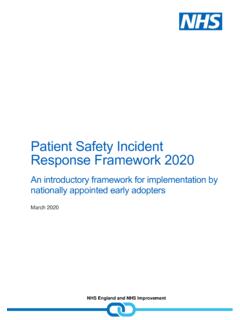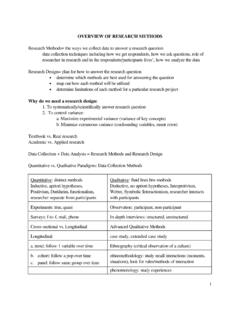Transcription of Chapter 3: Method (Exploratory Case Study)
1 Chapter 3: Method (Exploratory Case Study) This workbook is intended to help you to write Chapter 3 of your proposal. Each part of this workbook contains information that will help you to understand what should be included in Chapter 3 of your proposal: Critical points to include in each section. Issues to consider regarding alignment with other sections of the proposal. References to enhance your understanding of what is needed. When you have read each part of this workbook, write the corresponding section of your draft proposal. Look for Write Your Dissertation writing prompts throughout the workbook; each one presents a list of everything you should address.
2 Finally, each part of this workbook ends with two tools that will help you self-check your work: a checklist that highlights relevant advice from the Dissertation Handbook, and a list of tips provided by the Research Review you have completed all parts of this workbook, you can put your work from all the parts together and you should have a finished Chapter 3 of your decision tree in Table 1 will help you decide whether a case study is the appropriate design for your research. Examples for the various types of designs are provided so that you can see how other researchers used each 1: Decision tree for choosing the correct qualitative designDesignQuestions answeredWhen usedExampleCase StudyHow, why, WhatExploring a phenom-enon in context, using one or more data collection methods.
3 Describing in depth a case or , K. F. & Hara, N. (2007) Knowl-edge sharing in online environ-ments: A qualita-tive case study . American Society for Informa-tion Science and Technology, 58, 2310 do people experience a phenomenon?Understanding the essence of the lived experiences of a group of people surrounding a phenomenonBurton, C. R. (2000). Living with stroke: A phenomenological study . Journal of Advanced Nursing, 32, 301 309.(Cont.)1 Table 1: Decision tree for choosing the correct qualitative design (cont.)DesignQuestions answeredWhen usedExampleGrounded theoryWhat is the theory that explains the com-mon experiences or behaviors of a group of people?
4 Explaining why people behave in a certain mannerHarley, A. E., Buckworth, J., Katz, M., Willis, S., Odoms-Yound, A., & Heaney, C. A. (2009). Developing long-term physical activity par-ticipation: A grounded theory study with Afri-can American women. Health Education and Behavior; 36, 97 studyWhat are the shared patterns of a culture or a group?Describing a culture sharing groupBaillie J., & Lankshear, A. (2015). Patient and family perspectives on peritoneal dialysis at home: Findings from an ethnographic study . Journal of Clinical Nurs-ing, 24, 222 are the stories of the individual experi-ences of a specific individual?
5 Exploring the life of an individual or individualsPatsiopoulos, A. T.; & Buchanan, M. J. (2011). The practice of self-compassion in counsel-ing: A narrative inquiry. Professional Psychology: Research and Practice, 42, 301 decision tree in Table 2 will help you decide whether the exploratory case study is appro-priate for your study . Examples are provided so that you can see how other researchers used each type of case study for their of case studyQuestions answeredWhen usedExampleExploratoryHow, what?Used when there is no single set of , J. X., & Schwier, R. A. (2014). An exploratory case study of online instructors: Factors associated with instructor engagement.
6 International Journal of E-Learning and Distance Education, 29(1), 2 2: Decision tree for choosing the right case study (Cont.)2 Type of case studyQuestions answeredWhen usedExampleExplanatoryHow, why?Used to explain pre-sumed causal links that are too complex for sur-veys or experimentation (Yin, 2014).Chong, H., Wong, J. S., & Wang, X. (2014). An explanatory case study on cloud computing applications in the built environment. Automa-tion in Construction, 44, 152 are cases alike? How are cases different?Used to compare two or more cases. Sometimes referred to as multiple case study because there is more than one case.
7 But focus is on the comparison of the , A., Rialp, J., Urbano, D., & Valliant, Y. (2005). The born-global phenomenon: A comparative case study research. Journal of International Entrepre-neurship, 3, 133 (Stake, 2005)Can answer all above questions but focus is very specificUsed to better under-stand a specific m, I. Nolan, M.,& Lundh, U.(2005). We do thingsTogether A case study of couplehood in , 4(1), 7 22. InstrumentalUsed to provide insight into an issue or help refine a theory. The case plays a supportive role, helping us to under-stand something else. The case may or may not be seen as typical of other , L.
8 , Jackson, D., & Usher, K.(2007). STAMP: Componentsof observable behav-iour that indicate potential for patient violence in emer-gency departments. Journal of Advanced Nursing, 59, 11 19. to multiple case , J. W. (2003). Role stress in the professional life of the school music teacher: A collective case study . Journal of Research in MusicEducation, 51,124 136. 2: Decision tree for choosing the right case study (cont.)3 Research Method (This is the main heading for this Chapter )Introduce the Research Method section. (Do not use this heading for this section.)Background Reading for This SectionYour introduction to the Research Method section sets the stage for this Chapter .
9 Start by restating the purpose of your study and then present what will be in Chapter Points to Address for This SectionStart by restating the purpose of your study . This statement is the same as the purpose statement presented in Chapter 1. Briefly preview the focus of Chapter 3, identify the major topics to be covered in the Chapter , and end with a transitional sentence to the Description and Justification for Research Method and Description and Justification for Research Design for Alignment Purpose statement must be written exactly the same as it was in Chapter 1.
10 Introduction should align with subsequent sections of this Your DissertationIn your dissertation template, write your introduction section, addressing each of the following points: Restate the purpose statement. Preview what is in Chapter 3. Identify major topics covered in this Chapter . End with a transitional sentence to the next : Ensure that your writing is cohesive. The ideas should flow logically and with appropriate transitions between and justify your research Method . Background Reading for This SectionChapter 7 in the Field guide , particularly Section Method used for an exploratory case study is a qualitative Method .






